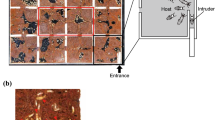Summary
In the laboratory, gynes (potential queens) of the paper wasp, Polistes fuscatus, exposed to both their natal nest and female nestmates (presumably their sisters) discriminate between female nestmates and unrelated females. However, gynes not exposed to their natal nest or conspecifics and gynes exposed only to female nestmates do not discriminate between female nestmates and unrelated females. Thus, the presence of the nest appears to be a requisite for the development of nestmate discrimination.
Similar content being viewed by others
References
Allen JL, Schulze-Kellman K, Gamboa GJ (1982) Clumping patterns during overwintering in the paper wasp, Polistes exclamans: effects of relatedness. J Kans Entomol Soc 55:97–100
Buckle GR, Greenberg L (1981) Nestmate recognition in sweat bees (Lasioglossum zephyrum): does an individual recognize its own odour or only odours of its nestmates? Anim Behav 29:802–809
Gamboa GJ, Dew HE (1981) Intracolonial communication by body oscillations in the paper wasp, Polistes metricus. Insectes Soc 28:13–26
Greenberg L (1979) Genetic component of bee odor in kin recognition. Science 206:1095–1097
Haggard CM, Gamboa GJ (1980) Seasonal variation in body size and reproductive condition of a paper wasp, Polistes metricus (Hymenoptera: Vespidae). Can Entomol 112:239–248
Hölldobler B, Michener CD (1980) Mechanisms of identification and discrimination in social Hymenoptera. In: Markl H (ed). Evolution of social behavior: hypotheses and empirical tests. Verlag Chemie, Weinheim (Dahlem Konferenzen 1980, pp 35–58)
Michener CD (1974) The social behavior of the bees. The Belknap Press of Harvard University, Cambridge, Massachusetts
Pfennig DW, Reeve HK, Shellman JS (1982) Learned component of nestmate discrimination in workers of a social wasp, Polistes fuscatus (Hymenoptera: Vespidae). Anim Behav (in press)
Post DC, Jeanne RL (1981) Colony defense against ants by Polistes fuscatus (Hymenoptera: Vespidae) in Wisconsin. J Kans Entomol Soc 54:599–615
Richards OW (1978) The social wasps of the America's exluding the Vespinae. British Museum (Natural History), London
Ross NM, Gamboa GJ (1981) Nestmate discrimination in social wasps (Polistes metricus, Hymenoptera: Vespidae). Behav Ecol Sociobiol 9:163–165
West Eberhard MJ (1969) The social biology of Polistine wasps. Misc Publ Mus Zool Univ Mich 140:1–101
Wilson EO (1971) The insect societies. The Belknap Press of Harvard University, Cambridge, Massachusetts
Author information
Authors and Affiliations
Rights and permissions
About this article
Cite this article
Shellman, J.S., Gamboa, G.J. Nestmate discrimination in social wasps: The role of exposure to nest and nestmates (Polistes fuscatus, Hymenoptera: Vespidae). Behav Ecol Sociobiol 11, 51–53 (1982). https://doi.org/10.1007/BF00297666
Received:
Accepted:
Issue Date:
DOI: https://doi.org/10.1007/BF00297666




